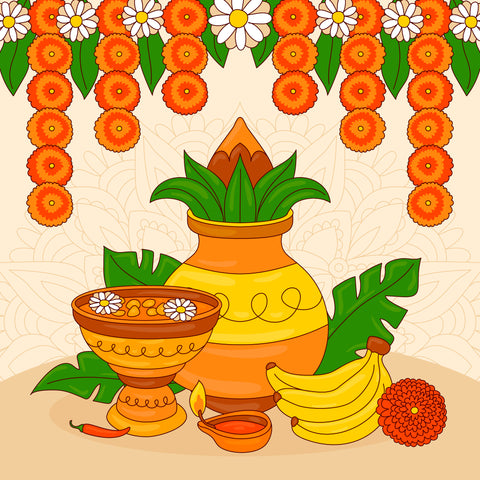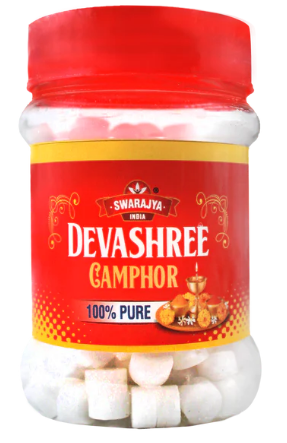HAPPY GUDI PADWA
Gudi Padwa 2024: History and Significance
A blessed Gudi Padwa 2024 greetings from Swarajya India. May the new year fill you with health and peace. Get ready to welcome the new year on April 9. The muhurat for this Gudi Padwa is from 11:50 pm on April 8 to 8:30 pm on April 9. Swarajya India, meeting all your puja ingredient needs – from oils to camphor and ghee and everything in between, hopes to be of total utility to every house celebrating Gudi Padwa.
The Celebration
Gudi is the flag. The word Padwa takes its origin from the Sanskrit word Pratipad for the first day of each fortnight in a lunar month or Amavasya – the first day on which the moon appears after the "new moon" day and the first day after the full moon.
Gudi Padwa is the new year of the people of Maharashtra, Goa & Daman. Gudi Padwa 2024 is a spring festival marking the start of the lunisolar new year for Hindus, primarily those of the Marathi and Konkani heritage. The festival falls at the start of the Chaitra month, the first month of the Hindu calendar. It is also the harvest festival in many parts, among the agriculturalists.
Why Gudi Padwa
-
There are several fascinating reasons behind the celebration of Gudi Padwa.
-
One popular belief links it to the triumphant return of Lord Rama to Ayodhya. After his epic victory over the demon king Ravana and the rescue of his wife Sita, Rama was crowned king. This joyous occasion is remembered on Gudi Padwa.
-
Another reason delves into Hindu mythology. The Brahma Purana tells the story of Lord Brahma reviving the world after a devastating event. Time itself stood still, and humanity was lost. But Brahma's intervention restarted time and ushered in a new era of righteousness. To honor this act of creation, Lord Brahma is worshipped on Gudi Padwa.
-
Finally, Gudi Padwa also commemorates a historical victory. The legendary Maratha warrior king, Chhatrapati Shivaji, is said to have begun celebrating Gudi Padwa after defeating the Mughal rulers. This tradition continues to this day, with every Marathi household raising the Gudi flag in celebration.
-

-
A key element of Gudi Padwa is the Dvaj flag. Imagine a vibrant cloth, like a sari or dhoti, adorned with beautiful garlands of flowers. Fresh mango leaves and neem leaves are added for a touch of nature, and the whole creation is crowned with a gleaming silver or copper vessel perched on top of the flagstaff.
- Festive decorations wouldn't be complete without rangolis! These colorful floor artworks are crafted using powders and flowers. The artist's creativity shines through in the choice of materials and the unique design of each rangoli.
The Religious Side of Gudi Padwa 2024
The front door of every Marathi house is decorated with mango leaves and marigold flowers. Every family member takes the traditional dip in the river, with the oil bath well prior, an essential part of the ritual of Gudi Padwa 2024. The bath begins the puja. The family then moves to the nearest temple for the rituals.
The Social Side
The traditional wear of the Maharashtrian male has changed. It now is the kurta pajama while the women wear the traditional nine-yard saree, their hair accessorized with a garland of mogra flowers. The religious rites apart, the Maharashtrian celebration begins with every member of the family adorning new attire and the traditional turban. Both men and women wear the turban and hit the street in what the locals call the Prabhat Pheri.
Among the most exciting and enjoyable revelry is the breaking of the coconut inside the gudi. The gudi is first hoisted. After the Gudi is hoisted, young men and adolescent and teenage boys form a human pyramid. The person climbing the top of the pyramid is tasked with trying to reach the Gudi and break the coconut that's inside. It's an important ritual of the festival and is followed almost everywhere in Maharashtra. Only men and adolescent boys are allowed to take part in this ritual.
A second ritual is to consume neem leaves. Neems is eaten raw, a custom marking the beginning of the festival. An alternative is preparing a paste by grinding the neem and then mixing it with jaggery and other seeds. The women prepare sweet dishes on the occasion. One of the dishes is the sweet and flat Indian bread, the Puran poli. Prepared like the Indian chapati, this is sweet to taste. A second is the Shrikhand. Shrikhand is used as a side dish with poori, puran poli, and chana.

For the womenfolk the celebrations also include dancing. They also participate in the dholak drumming and some riding activity, often on motorcycles.
Gift-giving is one of the major traditions of this festival when the elder members offer clothes, money, and other gifts to the younger members of the family.
During the celebration, there is one producer of puja ingredients that provides all of it under one roof – the oil, ghee, camphor, dhoop cups, ashtagandha, and the til oil used in the preparation of edible products like prasad in the puja.
Conclusion:
In Conclusion, Celebrate Gudi Padwa 2024, keeping in mind the Muhurats, although the festivities have a different tone of practices and celebrations as one travels from the villages to the metropolis. It is considered a festival associated with farming. Greeting all Maharashtrians a healthy and prosperous Gudi Padwa 2024.













